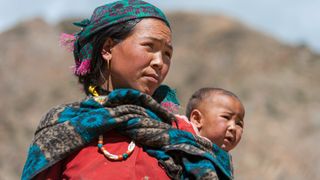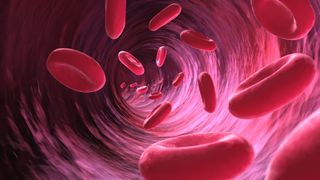Natural selection is unfolding right now in these remote villages in Nepal
Physiological traits that help Tibetan women survive at high altitudes are being selected for within the population, meaning they may be becoming more common, new research hints.

Natural selection is happening among humans right now — high up in the mountains of Nepal, scientists have discovered.
The new research suggests that, compared to their peers, ethnic Tibetan women who are physiologically better adapted to living in the low-oxygen conditions at high altitudes bear more children. This hints that these beneficial traits are currently being "selected for," meaning there's an evolutionary pressure to pass them on to the next generation.
In other words, natural selection is occurring.
The researchers revealed their findings in a study published Oct. 21 in the journal PNAS. The study looked at more than 400 women, ages 46 to 86, who live in villages located in the Upper Mustang District of Nepal on the border with Tibet. The villages sit 11,500 to 13,500 feet (3,500 to 4,100 meters) above sea level.
People who live at high altitudes face harsh environmental conditions, including low air pressure that reduces the amount of oxygen available in the body. These low oxygen levels can cause tissues to stop functioning, leading to symptoms such as confusion and difficulty breathing. In more severe cases of this condition, called hypoxia, people can develop deadly illnesses like acute mountain sickness or high-altitude cerebral edema, in which the brain swells.
Low-oxygen environments are especially challenging for pregnant women at higher altitudes, due to a heightened risk of preeclampsia, a potentially fatal blood-pressure condition, and are more likely to give birth to babies with low birth weights. Therefore, in populations living at high altitudes, there may be strong selective pressures for traits that help increase survival, both during and after pregnancy.
Sign up for the Live Science daily newsletter now
Get the world’s most fascinating discoveries delivered straight to your inbox.
Previous research has shown that Tibetans have physiological traits and versions of genes that help them to survive in low-oxygen environments more easily than people without these characteristics. In the new study, researchers wanted to see if they could link these genetic and physiological traits with reproductive success to show that evolution is happening via natural selection in these populations.
In biology, "reproductive success" is typically measured through a tally of how many offspring an organism has produced, because that reflects the number of times they've passed on their genes. So the researchers recorded how many children the women in these villages had given birth to. They also took various physiological measurements and analyzed the women's DNA.

They found that the women who bore the most children carried typical levels of hemoglobin — the blood responsible for transporting oxygen. But their hemoglobin was capable of carrying more oxygen than women who had fewer children.
Furthermore, the women with more children had greater blood flow to their lungs. And their left ventricles — the chamber of the heart that pumps oxygenated blood to the body — were wider than those with fewer children. A wider ventricle means more oxygen-rich blood can get to a person's tissues in a given heartbeat.
In a separate analysis, the researchers found that around 80% of the women in the study carried a version of a gene known as EPAS1, which is thought to lower hemoglobin concentrations in the blood. This may seem counterintuitive as having less hemoglobin means you can't carry as much oxygen in the blood. However, too much hemoglobin can thicken the blood, making people vulnerable to developing a condition known as chronic mountain sickness.
The fact that the EPAS1 variant is so common suggests there is a lot of pressure for this version of the gene to be passed on from one generation to the next.
These new findings shed light on how evolution and adaptation occurs in humans, study co-author Cynthia Beall, a professor emerita of anthropology at Case Western Reserve University in Ohio, told Live Science. The findings may also have applications in medicine — for instance, they could potentially provide insight into diseases that are associated with low oxygen levels, such as asthma and other lung conditions, she suggested.
Ever wonder why some people build muscle more easily than others or why freckles come out in the sun? Send us your questions about how the human body works to community@livescience.com with the subject line "Health Desk Q," and you may see your question answered on the website!

Emily is a health news writer based in London, United Kingdom. She holds a bachelor's degree in biology from Durham University and a master's degree in clinical and therapeutic neuroscience from Oxford University. She has worked in science communication, medical writing and as a local news reporter while undertaking journalism training. In 2018, she was named one of MHP Communications' 30 journalists to watch under 30. (emily.cooke@futurenet.com)
Most Popular

